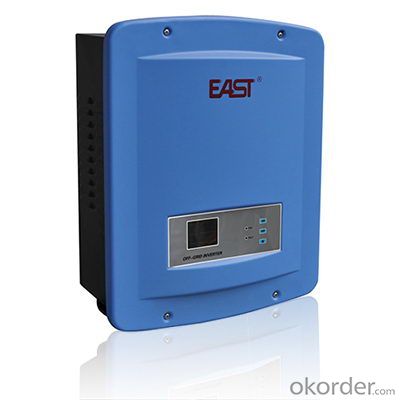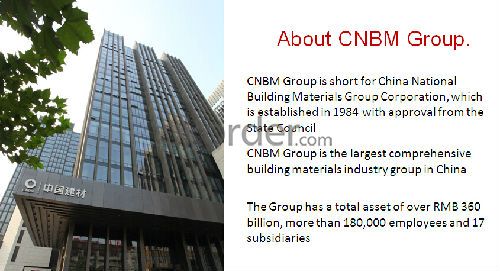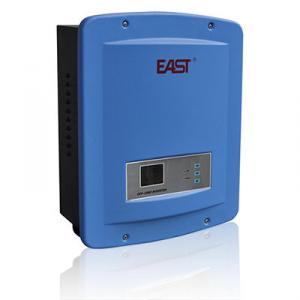Off-Grid Solar Inverter 100W-2400W Excellent Performance, Hige Stability
- Loading Port:
- China main port
- Payment Terms:
- TT or LC
- Min Order Qty:
- 1 pc
- Supply Capability:
- 1000 pc/month
OKorder Service Pledge
OKorder Financial Service
You Might Also Like
Off-Grid Solar Inverter 100W-2400W
EA-GF series products are on the basis of green energy use and equipment electricity need for remote area, combing the electricity characteristics of household appliances, communication station equipment and computer peripheral equipment. They have the fuction of enery conservation and environment protection. They adopt MCU control techniqute, having various kinds of function such as multi-setting mode, MPPT control, voltage stabilization on line, short-circuit protection, inverter frequency adaptive, output overload, batter charging management, monitoring etc. EA-GFseries products are the ideal power supply delivered with excellent performance, hige stability, high reliability and practical applicability.
● Multi-setting
※PV priority mode or AC priority mode
※Choose the charging current based on the configured capacity of the battery
● High reliability: Double MCU digital control
※Independent MPPT (Maximum Power Point Tracking) control microprocessor system
※Independent inverter microprocessor control system
● Isolated and pure sine wave technology
● LCD+LED display
● Wide input range
● High-speed synchronous conversion
● Friendly alarm system
● Online protection function
● Frequency auto adaptive
● Intelligent No-load auto shutdown technology (optional)
● Intelligent monitoring (RS232, USB, or SNMP card, optional)
Model | GF100 | GF400 | GF500 | GF800 | GF1000 | GF1500 | GF2000 | GF2400 | |
Power | 100W | 400W | 500W | 800W | 1000W | 1500W | 2000W | 2400W | |
Battery Voltage | 12Vdc | 12Vdc / 24Vdc | 24Vdc | 24Vdc | 48Vdc | 48Vdc | |||
Working Mode | PV priority / AC priority | ||||||||
PV | |||||||||
Input Voltage Range | 12Vdc-25Vdc | 12Vdc-25Vdc(12V) 24Vdc-45Vdc(24V) | 24Vdc-45Vdc | 48Vdc-90Vdc | |||||
Suggested Voltage Range(Vmp) | 15Vdc-17.8Vdc | 15Vdc-17.8Vdc(12V) 30Vdc-36Vdc(24V) | 30Vdc-36Vdc | 60Vdc-71Vdc | |||||
PV Current(Imp) | ≤20A | ≤40A | ≤40A | ≤60A | ≤80A | ||||
Max. Charge Current | 5A/10A/20A | 10A/20A/30A/40A | 10A/20A/30A/60A | ||||||
Conversion Efficiency | ≥ 98% | ||||||||
Display | |||||||||
Panel Indicator | LCD + LED | ||||||||
AC mode | |||||||||
Input Voltage Range | 100/110/120/220/230/240VAC±25%(customized) | ||||||||
Input Frequency Range | 45-65 Hz(Automatically transfer to inverter power when overfrequency) | ||||||||
Output Voltage Precision | 100/110/120/220/230/240VAC± 10% | ||||||||
Input PF.(AC/DC) | ≥98% | ||||||||
Charge Current | 12A max | ||||||||
Efficiency (Mains Mode) | ≥ 96% | ||||||||
Overload | 110% 255s transfer to bypass model; 120% 60s transfer to bypass model; 150% 10s transfer to bypass model; | ||||||||
Short Circuit Protection | Input fuse | ||||||||
Inverter Mode | |||||||||
Inverter Output Voltage | 100/110/120/220/230/240VAC± 5% | ||||||||
Output Frequency | 50 Hz / 60Hz ± 1% frequency auto sense | ||||||||
Wave Form Distortion | Linear load≤ 5% | ||||||||
PV-AC Transfer Time | 5 ms typical value; Max.8 ms | ||||||||
Max.Efficiency | ≥ 84.5% | ||||||||
Inverter Overload | 110% 255s transfer to bypass model; 120% 60s transfer to bypass model; 150% 1s transfer to bypass model; | ||||||||
No-Load Off(Optional) | Load< 5% The system automatically shut down at 1MIN, transfer to bypass power supply | ||||||||
Short Circuit Protection | Systems automatically shut down | ||||||||
Alarm | |||||||||
Mains Abnormal | 1/4s; automatic sound elimination after 40s | ||||||||
Low Battery | 5/1s | ||||||||
Overload | 1/1s | ||||||||
Communication Interface(Optional) | RS232 / USB / SNMP(Setup available for regular start/shutoff) | ||||||||
Others | |||||||||
Surge Protection | Optional | ||||||||
EMC | EN62040-2:2006;EN61000-3-2:2006; EN61000-3-3:2008 | ||||||||
IP Class | IP21 | ||||||||
Ambient Temperature | 0℃ ~ 40℃ | ||||||||
Ambient Humidity | 10% ~ 90%(Non Condensed) | ||||||||
Noise | ≤ 50dB | ||||||||
Dimension (WxDxH)mm | 315×458×147 | 380×480×202 | |||||||
Packing Dimension (WxDxH)mm | 380×500×195 | 458×545×278 | |||||||
Weight (kg) | 9.8 | 11.0 | 12.0 | 18.7 | 19.2 | 19.6 | 27.6 | 29.3 | 29.3 |
Packing Weight (kg) | 10.8 | 12.0 | 13.0 | 20.0 | 20.5 | 20.9 | 28.9 | 30.6 | 30.6 |





· Q. What is an UPS and What it is for ?
An uninterruptible power supply (UPS) is a device that allows your computer or telephone switch or critical equipement to keep running for at least a short time or longer time when the primary power source is lost. It also provides protection from power surges, spikes, brownouts, interference and other unwanted problems on the supported equipment.
· Q. How long the UPS to run when power goes?
This can take 3 paths.
1.You can pick a UPS that is rated for pretty much the full VA you need so it will be running at 100% of capability and will thus last 'n' minutes.
2.You can pick a UPS that is rated at a much higher VA value than you really need so, for example, is running at 50% of capability and will thus last for longer than the UPS from option 1.
3.You can use extra external battery packs to run for longer. If charging capability allows, the more and the bigger batteries you take with, the longer time UPS runs.
or using a generator after about 6 hours, it will be more cost-effective, with a short runtime UPS to bridge the generator start-up gap.
- Q:How does a solar inverter handle variations in solar panel tilt and orientation?
- A solar inverter can handle variations in solar panel tilt and orientation by continuously adjusting its output voltage and current to match the changing conditions. It does this through a process called maximum power point tracking (MPPT), which optimizes the energy output of the solar panels by finding the point where the panels generate the maximum power. By dynamically adjusting the voltage and current, the solar inverter ensures that it operates at the optimal point, regardless of the tilt or orientation of the panels. This allows for efficient energy conversion and maximizes the overall power generation from the solar system.
- Q:What is the maximum power capacity of a solar inverter?
- The maximum power capacity of a solar inverter can vary depending on the specific model and brand. However, in general, solar inverters can have power capacities ranging from a few hundred watts to several kilowatts, with some larger industrial-grade inverters capable of handling even higher power capacities.
- Q:Can a solar inverter be used in a solar-powered electric vehicle charging station?
- Yes, a solar inverter can be used in a solar-powered electric vehicle charging station. A solar inverter is responsible for converting the Direct Current (DC) generated by solar panels into Alternating Current (AC) that can be used to charge electric vehicles. Therefore, it is an essential component in a solar-powered EV charging station, allowing the electricity generated from solar panels to be compatible with the charging needs of electric vehicles.
- Q:What certifications should I look for when choosing a solar inverter?
- When choosing a solar inverter, it is important to look for certifications such as UL listing, IEC 61727 compliance, and IEEE 1547 compliance. These certifications ensure that the inverter meets safety and performance standards, and is compatible with grid connection requirements.
- Q:What is the typical lifespan of the capacitors in a solar inverter?
- The lifespan of capacitors in a solar inverter can differ based on various factors including component quality, operating conditions, and stress levels. On average, the expected lifespan is approximately 10 to 15 years. Capacitors serve a vital role in a solar inverter as they store and release electrical energy. They assist in voltage regulation, smoothing out power fluctuations, and providing stability to the electrical system. Several factors influence the lifespan of capacitors in a solar inverter. The quality of the capacitors themselves is a significant factor. Higher quality capacitors generally offer better performance and durability, resulting in a lengthier lifespan. Conversely, cheaper or lower-quality capacitors may deteriorate or fail more rapidly. Operating conditions also impact the lifespan of capacitors. Solar inverters are typically installed outdoors and are exposed to environmental factors such as temperature variations, moisture, and sunlight. Extreme temperatures, excessive humidity, or direct sunlight can accelerate capacitor deterioration and decrease their lifespan. Moreover, the stress placed on capacitors affects their lifespan. Voltage fluctuations, high-frequency switching, and overloading of the inverter can all contribute to this stress. Operating a solar inverter beyond its design limits or experiencing frequent power fluctuations can strain the capacitors, potentially resulting in premature failure. Regular maintenance and monitoring of the solar inverter are crucial for promptly identifying any potential capacitor issues. Some manufacturers may provide warranties or information on the expected lifespan of their capacitors, providing insight into their durability. In conclusion, the typical lifespan of capacitors in a solar inverter ranges from 10 to 15 years, but this can vary due to factors such as component quality, operating conditions, and stress levels. Regular maintenance and monitoring are essential for ensuring the capacitors' longevity and optimal performance within a solar inverter system.
- Q:What is the maximum number of AC outputs in a solar inverter?
- The maximum number of AC outputs in a solar inverter can vary depending on the specific model and design, but typically it ranges from one to three AC outputs.
- Q:How long does a solar inverter last?
- A solar inverter typically lasts between 10 to 20 years, depending on various factors such as quality, usage, maintenance, and environmental conditions.
- Q:Can a solar inverter be used with solar-powered emergency backup systems?
- Yes, a solar inverter can be used with solar-powered emergency backup systems. The solar inverter is an essential component that converts the DC (direct current) power generated by the solar panels into AC (alternating current) power, which can be used to power various electrical devices and appliances during emergencies.
- Q:Can a solar inverter be used with a solar-powered water pump?
- Yes, a solar inverter can be used with a solar-powered water pump. A solar inverter converts the direct current (DC) generated by solar panels into alternating current (AC) that can be used to power various electrical devices, including water pumps. This allows the solar panels to directly power the water pump, making it an efficient and sustainable solution for water pumping applications.
- Q:Does a solar inverter require any additional cooling or ventilation?
- Yes, a solar inverter typically requires additional cooling or ventilation. This is because the inverter converts the direct current (DC) generated by solar panels into alternating current (AC) that can be used to power household appliances. During this conversion process, the inverter generates heat, and to maintain optimal performance and prevent overheating, it requires proper cooling or ventilation mechanisms.
1. Manufacturer Overview |
|
|---|---|
| Location | |
| Year Established | |
| Annual Output Value | |
| Main Markets | |
| Company Certifications | |
2. Manufacturer Certificates |
|
|---|---|
| a) Certification Name | |
| Range | |
| Reference | |
| Validity Period | |
3. Manufacturer Capability |
|
|---|---|
| a)Trade Capacity | |
| Nearest Port | |
| Export Percentage | |
| No.of Employees in Trade Department | |
| Language Spoken: | |
| b)Factory Information | |
| Factory Size: | |
| No. of Production Lines | |
| Contract Manufacturing | |
| Product Price Range | |
Send your message to us
Off-Grid Solar Inverter 100W-2400W Excellent Performance, Hige Stability
- Loading Port:
- China main port
- Payment Terms:
- TT or LC
- Min Order Qty:
- 1 pc
- Supply Capability:
- 1000 pc/month
OKorder Service Pledge
OKorder Financial Service
Similar products
New products
Hot products
Hot Searches
Related keywords































